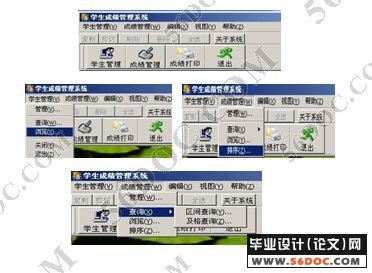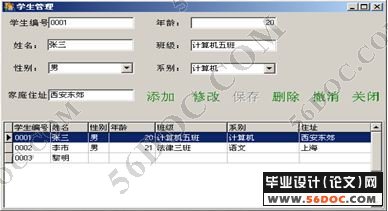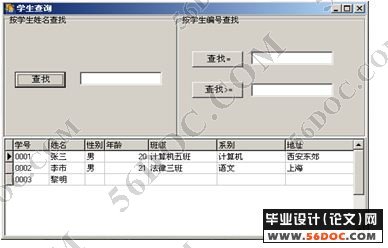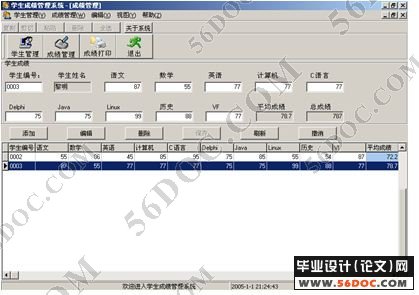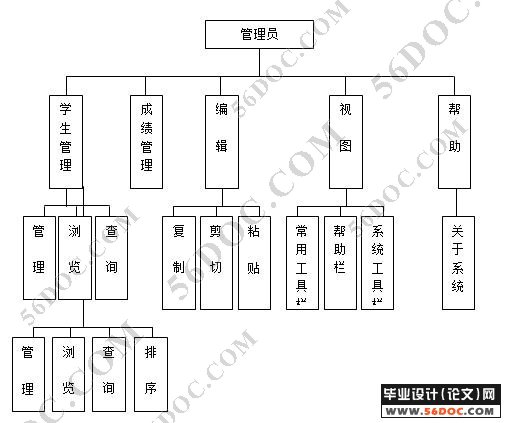摘要
本系统全称为学生成绩管理系统。根据开发要求,它主要应用于教育系统,完成对日常的教学、教务、教师以及学生的计算机化的管理。开发学生成绩管理系统可使学院教职员工减轻工作压力,比较系统地对教务、教学上的各项服务和信息进行管理,同时,可以减少劳动力的使用,加快查询速度、加强管理,以及国家各部门关于信息化的步伐,使各项管理更加规范化。目前,学校工作繁杂、资料重多。目前,管理信息系统已进入高校,但还未普及,而对于学生成绩管理来说,目前还没有一套完整的、统一的系统。因此,开发一套适和大众的、兼容性好的系统是很有必要的。
本系统管理内容广泛,全面涉及了教务教学上的各项服务,包括学生成绩管理,其中有学生成绩管理;学生管理等等。在开发过程中,注意使其符合操作的业务流程,并力求系统的全面性、通用性,使得本系统不只适用于一家教育机构。在开发方法的选择上,选择了生命周期法与原型法相结合的方法,遵循系统调查研究、系统分析、系统设计和系统实施四个主要阶段进行设计,而在具体的设计上,采取了演化式原型法,随着用户的使用及对系统了解的不断加深,对某一部分或几部分进行重新分析、设计、实施。在开发工具的选择上,主要利用Delphi7.0 编程语言进行开发,使用其自带的数据库,从而保证了数据的完整性与一致性。本论文主要从系统分析、系统设计、系统实施与使用等几个方面进行介绍。
关键词:信息管理系统 信息化 成绩管理 数据库 Delphi7.0
ABSTRACT
The name of our system is grade Management System.According to the requirements of developing, the system is mainly applied to education system which manageas the daily teaching educational administration and computeration of teachers and students. Developing grade Management System can not only ruduce the presure of the staff and systematically manage the service and information, but also decrease the use of labour force, accelerate the requiring speed, improve management, speed the pace of concernad national department autumated information retrieval to standardize the managements. Nowdays, the universities work are miscellaneous,especially in private ones.It's important to put the teachers' management on the table. Up to now, mamagement has come into universities but not popularized. As for the teaching management, there is not a set of complete and unified system, so it's very necessary to develop a common,compatible one.
The system is wide and comprehensive in including most of the service items of teaching plans, such as grade management which refers to teaching plans, grade management, students management and so on. In developing procedure, we pursure the comprehensiveness and commomality of the system, so that it can not only be applied in one educational institution. In choosing the developing methods, we combine the life sycle approach and the prototype-based approach, approach in four main steps: system investigation, system analysis, system design and system implementation. AS to data design, evolutionary prototype-based approach is partialy adopted to reanalysize, redisign and reimplemate with the user's ever-increasing understanding of the system. In choosing the developing tool, Delphi 7.0 programming language is employed. In line of its self-sustaining. to ensure the integratedness and consistency. This thesis mainly introduce the ideas of the analysizing ,designing ,implementing and application of this system.
Keywords: information management system autumated information retrieval life cycle approach prototype-based approach
前言
学生成绩管理系统是一个典型的信息管理系统,其开发主要包括后台数据库的建立与维护,以及前端应用程序的开发这两个方面。对于前者要求建立起数据一致性和完整性强、数据安全性好的库,而对于后者则要求应用程序的功能完备、易使用等特点。由此分析,选择了美国Borland公司推出的 Delphi 7.0 开发工具。
随着社会进步,社会对人才素质要求越来越高,相应的,需要学校的工作也越来越全面、周到、先进、高效。这不仅使教务管理的日常工作日趋复杂繁重,而且,对它提出了更高的要求。
学生成绩管理系统强化了教务管理的职能,涵盖了学生成绩管理、学生管理、系统维护等等主要功能,对教务管理工作进行了提炼和概括,使教务管理工作日益规范化、制度化和科学化。此学生成绩管理系统的使用,大大减少了管理者的手工劳动,是学校管理的得力助手。
目录 12000字
第1章 绪论………………………………………………………………1
1.1问题的提出………………………………………………………………1
1.2现有系统存在问题的分析………………………………………………………1
1.3系统开发目标………………………………………………………………2
1.4开发工具的选择………………………………………………………………2
1.5开发方法的选择………………………………………………………………2
1.5.1系统分析………………………………………………………………3
1.5.2系统设计………………………………………………………………4
1.5.3系统实施………………………………………………………………4
1.5.4调试维护………………………………………………………………5
1.6开发本系统的意义………………………………………………………………5
第2章 系统分析………………………………………………………6
2.1背景分析 ………………………………………………………………6
2.2组织机构调查分析 ……………………………………………………………6
2.3可行性分析………………………………………………………………6
2.3.1技术可行性分析…………………………………………………………7
2.3.2经济可行性………………………………………………………………7
2.3.3运行可行性………………………………………………………………7
2.4详细调查 ………………………………………………………………8
2.4.1资料收集 ………………………………………………………………8
2.4.2业务流程调查分析 ………………………………………………………8
2.5数据流程的分析 ………………………………………………………………9
2.6数据分析 ………………………………………………………………9
2.6.1数据属性………………………………………………………………9
2.6.2查询分析………………………………………………………………10
2.7选购设备 ………………………………………………………………10
第3章 系统设计…………………………………………………………11
3.1代码设计 ………………………………………………………………11
3.2系统物理设计 ………………………………………………………………11
3.2.1拓扑结构设计 ……………………………………………………………11
3.2.2设备选择 ………………………………………………………………13
3.2.3系统环境 ………………………………………………………………12
3.3数据库设计 ………………………………………………………………12
3.3.1概念模式设计 ……………………………………………………………12
3.3.2逻辑设计 ………………………………………………………………13
3.3.3物理设计 …………………………………………………………………13
3.4功能结构图 ……………………………………………………………………13
3.5信息系统流程图 …………………………………………………………14
第4章系统实施……………………………………………………………16
4.1物理实施………………………………………………………………………16
4.2程序设计………………………………………………………………………16
4.3调试……………………………………………………………………………24
4.3.1模块测试…………………………………………………………………24
4.3.2系统测试…………………………………………………………………24
4.4编译……………………………………………………………………………24
4.5使用说明书……………………………………………………………………24
4.6维护……………………………………………………………………………24
第5章 结论……………………………………………………………25
5.1取得的成绩……………………………………………………………………25
5.2 不足之处………………………………………………………………………25
5.3 建议……………………………………………………………………………25
5.4 心得……………………………………………………………………………25
致谢…………………………………………………………………………27
参 考 文 献…………………………………………………………………28
附录…………………………………………………………………………29
附录1 设备表……………………………………………………………29
附录2 源代码…………………………………………………………………29
|


